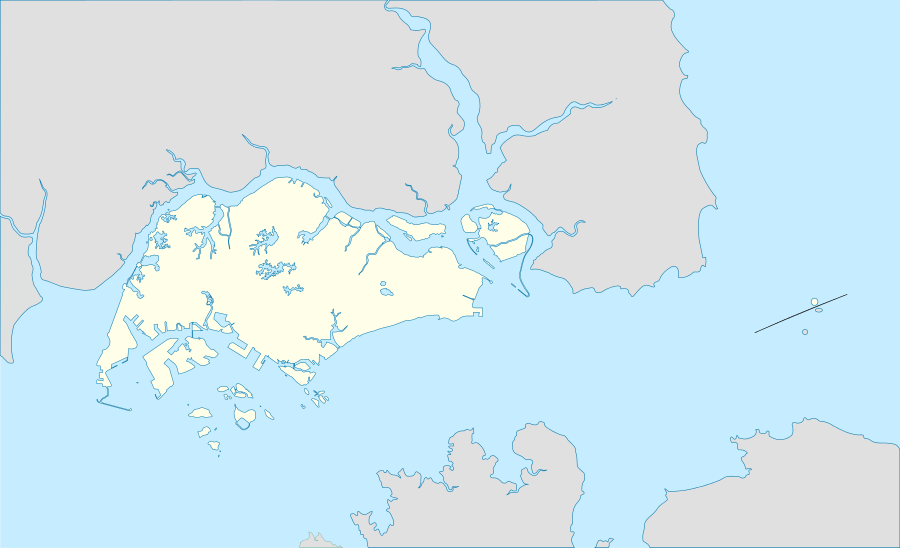Bidadari Cemetery
 The gate of the former cemetery, now located in a small memorial garden called Bidadari Garden at 10 Mount Vernon | |
 Location within Singapore | |
| Details | |
|---|---|
| Established | 1908 |
| Closed | 1972 |
| Location | Bidadari, Toa Payoh |
| Country | Singapore |
| Coordinates | Coordinates: 1°20′7.53″N 103°52′19.21″E / 1.3354250°N 103.8720028°E |
| Type | Defunct |
| Find a Grave | Bidadari Cemetery |
Bidadari Cemetery (Malay: Perkuburan Bidadari, Chinese: 比达达利坟场) is a defunct cemetery in Singapore. It used to serve the Christian, Muslim, Hindu and Sinhalese communities.
History
The site of Bidadari Cemetery used to be the Istana residence of one of Johore Sultan Abubakar's wives.[1]
The word bidadari means "fairy" in Malay, which was in turn derived from the Sanskrit word vidhya dhari, which means a nymph[2] of India's heaven or a houri of paradise. The bidadari are depicted as kindly fairies and genies that preside over the union of flowers. In the local context, the name is a reference to the beauty of the wife of Abu Bakar of Johor who had a house there. The cemetery took the name after the sultan's wife ceased to reside there. The grounds were leased to a Japanese person who built moats with typical Japanese wooden bridges and a teahouse.
There were two sections in the cemetery: the Muslim section was at the base of Mount Vernon, bounded by Upper Aljunied Road, Upper Serangoon Road, and Bartley Road; the Christian section was across Upper Aljunied Road from the Muslim section, and bounded by Upper Serangoon Road as well.
Apart from being a place of remembrance, the trails inside Bidadari Cemetery used to be very popular as a running route for members of the Gurkha Contingent.
Burials were not permitted after 1972,[3] the same year that the Mount Vernon Crematorium and Columbarium was opened, which too eventually closed in 2004 due to redevelopment plans drawn up by the Urban Redevelopment Authority (URA).[1]
Present Day
Bidadari Cemetery is no longer in use, and most or all of the graves have been eventually exhumed between 2001 and 2004 for redevelopment in the land-scarce city-state. It was re-opened as a temporary park[4] in 2006. Woodleigh MRT Station now occupies part of the former site.[1] In late 2011, the Ministry of National Development (MND), came up with the blueprint to develop the area into a housing estate with HDB flats and private housing. Works begun in 2012 to build the houses, with the first batch of BTO HDB flats expected to be ready by 2018.
The Bidadari Memorial Garden was set up at nearby Mount Vernon Road[5] to commemorate the cemetery.
Notable Burials
Bidadari had sections for Hindus, Muslims and Christians and many prominent people were buried here.[6][7]
- Ahmad bin Ibrahim – Minister of Health and Minister of Labour
- Regent Alfred John Bidwell British architect of Swan and Maclaren
- Douglas Campbell – British advisor in Johor
- Dr and Mrs Lim Boon Keng
- Sir Song Ong Siang
- John Laycock
- Sir George Edward Noel Oehlers
- Syarif Masahor – Sarawak warrior
- Augustine Podmore Williams, an English sailor, on whose life Joseph Conrad based his novel Lord Jim.
- Sir Duncan George Steward - Second Governor of Crown Colony of Sarawak
- L/Cpl Thomas (Big Tam) Darling - The Queen's Own Cameron Highlanders and LT Malaya Police
See also
References
- 1 2 3 Bidadari Cemetery, Singapore Infopedia.
- ↑ Goh, Si Guim. "Twilight for Bidadari". Retrieved 16 February 2015.
- ↑ "Singaporeans unfazed by Bidadari's cemetery past for planned HDB estate". Retrieved 16 February 2015.
- ↑ "Bidadari Cemetery". Retrieved 16 February 2015.
- ↑ "Bidadari Garden". Find A Grave. Retrieved 16 February 2015.
- ↑ Yeo, Nick. "Bidadari Cemetery". Retrieved 16 February 2015.
- ↑ "Bidadari Memorial Garden". National Heritage Board. Archived from the original on 25 November 2015. Retrieved 25 November 2015.
Bibliography
- Victor R Savage, Brenda S A Yeoh (2004), Toponymics - A Study of Singapore Street Names, Eastern University Press, ISBN 981-210-364-3.
| Wikimedia Commons has media related to Bidadari Garden. |